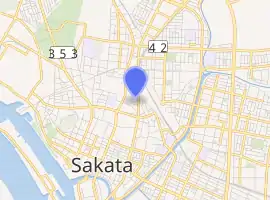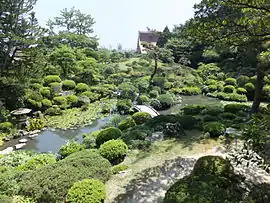Homma Museum of Art
Homma Museum of Art (本間美術館, Homma bijutsukan) opened in Sakata, Yamagata Prefecture, Japan, in 1947.
| Homma Museum of Art | |
|---|---|
本間美術館 | |
 | |

| |
| General information | |
| Address | 7-7 Onari-chō |
| Town or city | Sakata, Yamagata Prefecture |
| Country | Japan |
| Coordinates | 38°55′24″N 139°50′32″E |
| Opened | 1947 |
| Website | |
| www | |
Setting
The Seienkaku (清遠閣) residence was built in 1813 by the fourth head of the Homma family (本間氏), Junji Homma, who was a noted collector of Japanese swords and chairman of the Nihon Bijutsu Token Hozon Kyokai. The Homma family was one of the great merchant houses of Sakata during the Edo Period, growing rich on the kitamaebune coastal trade and by moneylending. During the Meiji period, they were one of then largest landowners in the Tohoku region of Japan. The Seienkaku villa was built as a secondary residence and guest house. Visitors include members of the Sakai and Uesugi clans, former daimyō of the Shōnai and Yonezawa Domains, as well as in 1925 the future Shōwa emperor. A second story was added to the wooden building in 1908 in advance of a planned visit by the future Taishō emperor.[1][2] It was opened as an art museum from 1947, and a modern annex was added in 1968.[1][3]
Collection
.jpg.webp)
The collection of some 2,500 objects includes a Kamakura-period edition of Ise Monogatari and three other Important Cultural Properties, works by Kanō Tan'yū, Nagasawa Rosetsu, Itō Jakuchū, Shiba Kōkan, Matsumura Goshun, Okada Hankō, Kishi Ganku, Kita Genki (喜多元規), Fukuhara Gogaku (福原五岳), Minagawa Kien (皆川淇園), Yasuda Raishū (安田雷洲), and Kuroda Seiki, as well as Goryeo celadons, raku ware by Chōjirō, lacquerware, sculptures, and Japanese traditional dolls.[1][5]
Kakubu-en gardens

The Kakubu-en (鶴舞園) or "Dancing Crane" Gardens, is designated a National Place of Scenic Beauty. It incorporates Mount Chōkai by way of borrowed scenery.[1][6]
Folk song
The folk song 'Homma Sama is out of our reach but we wanna be Tonosama at least' shows the prosperity of the Homma family when "Tonosama" as the top of warrior class was ranked highest according to the social class system (Emperor, Court Nobility, Shōgun, Daimyō, Samurai, Peasants, Craftsmen and Merchants) established in the early Edo period (See also Edo period#Society).[7]
See also
References
| Wikimedia Commons has media related to Homma Museum of Art. |
- "Homma Museum of Art". Cabinet Office, Government of Japan. Retrieved 18 October 2015.
- 公益財団法人 本間美術館 [Homma Museum of Art] (in Japanese). Agency for Cultural Affairs. Retrieved 18 October 2015.
- "Museums in Yamagata - Homma Museum of Art". Yamagata Prefectural Museum. Retrieved 18 October 2015.
- 紙本淡彩鼬図 伝円山応挙筆 [Weasels, light colour on paper, attributed to Maruyama Okyo] (in Japanese). Yamagata Prefecture. Retrieved 18 October 2015.
- コレクション [Collection] (in Japanese). Homma Museum of Art. Retrieved 18 October 2015.
- 本間氏別邸庭園(鶴舞園) [Honma Family Detached Residence Gardens (Kakubu-en)] (in Japanese). Agency for Cultural Affairs. Retrieved 18 October 2015.
- 豪商・本間光丘~「本間様には及びもないが せめてなりたや殿様に」[Mitsuoka Homma, business magnate〜 'Homma Sama is out of our reach but we wanna be Tonosama at least'] (in Japanese)
External links
- (in Japanese) Homma Museum of Art
- (in Japanese) Collection
